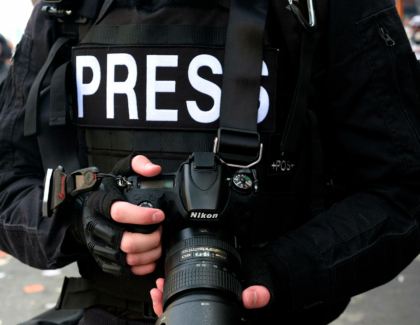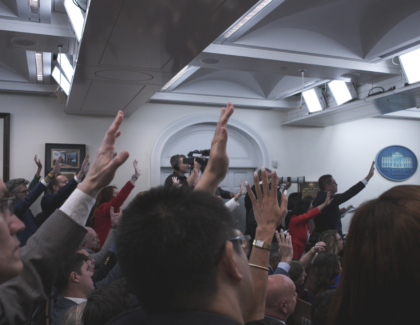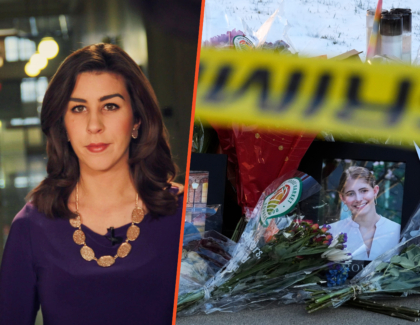Sign up for the daily CJR newsletter.
As the staff of The Phoenix convened for a meeting one afternoon, Yessibel Aquino, the co–editor in chief, was standing in a back corner of the room, fiddling nervously with her silver necklace and the long, royal-blue front pieces of her hair. She was new on the job, a novice at journalism, and unused to being in charge. All understandable: she is fourteen. If she hadn’t missed the deadline to sign up for volleyball, she may not have joined the Phoenix staff at all.
Until late last year, Aquino’s school—the Community Health Academy of the Heights (CHAH), a combined middle and high school in Upper Manhattan—didn’t have a student publication. Then the principal heard about a tiny nonprofit called Press Pass NYC, which aims to start student publications at under-resourced public schools around the city. He suggested that a second-year teacher named Mira Soni apply to the program, which provides summer training and ongoing workshops and coaching for newsroom advisers. Soni was accepted, completed the training last summer, and officially debuted The Phoenix as an online publication in December.
At the meeting, members of the staff were gossiping and occasionally shooting one another with water from a spray bottle. Aquino stepped forward. “Put your phone away!” she told a colleague. Another said he would not be able to meet his deadline. Aquino agreed to push it by a week—but ordered him to write down the new date so he wouldn’t forget. “I was kind of nervous at first because I don’t see myself as being a person who’s in charge,” she said. “But, you know, after spending some time with the others, it was kind of easy to manage because they listen to me.”
In New York City, according to a 2022 report, just 27 percent of high schools have a newspaper in print or online. At the hundred schools with the highest poverty rates, the number drops to 7 percent. Schools with high proportions of Black and Latino students are also less likely to have student publications. CHAH ticks both boxes, with 95 percent Black or Latino students and 93 percent “economically disadvantaged” kids.
Soni, who teaches English-language learners, is an energetic and committed mentor. As part of her introduction to running a news organization, she’d received worksheets that help students plan interviews and map out stories. A story assignment sheet starts with a headline suggestion, then asks for “potential/probable angle,” “key questions to answer,” and “key people to interview.” An outline worksheet has boxes for the lede, nut graf (including who, what, where, when, why, and how), lead quote, transition, quote, transition, quote, transition, and kicker. Soni has followed the templates religiously, sitting down with each student—or, increasingly, asking Aquino or her coeditor to do it—until every line is filled out.
Soni now leads a staff of eight—half of them in middle school—covering all things CHAH. So far, stories have skewed toward the light and evergreen: “The Many Great Performances at CHAH’s Winter Concert,” “What to Know About CHAH Clubs,” and “CHAH Should Encourage More Class Pets.” Aquino wrote a feature about whether school security guards should be armed, but none of the reporters are at work uncovering scandals. Some of the staff, including Aquino’s coeditor, can’t yet write in English, so The Phoenix publishes some articles exclusively in Spanish; others appear in both languages. “My lack of knowledge about how to run a newsroom supported the kids’ feeling independent,” Soni said. “I was like, ‘You can write about literally whatever you want. I’m not going to assign stories, because I don’t know how to do that.’”
Soni is also vexed by a challenge known to most news publishers: growing a readership. When the site launched, Soni took over a bulletin board near the school’s elevator to display her students’ stories, including a QR code to access the Phoenix homepage and Instagram handle. But neither she nor Aquino thinks that many people are looking at the coverage. “Part of me worries, What if they decide we can’t do this anymore because the school is under-enrolled and the needs are too high?, and they just take it away,” Soni said. “So I have to have something to show that this is good for the kids.”
For the students working on The Phoenix, the benefits are clear: research shows that high schoolers who are involved in journalism earn higher GPAs and ACT scores than their peers and perform better in college English classes. Most professionals, though, tend to think of the primary value of a news outlet as being for the public, not for its staff. Soni agreed to start the paper because, she said, “it’s hard to see yourself as a writer if no one is reading your writing except for your teacher.” But fewer than half of teenagers report seeing news coverage on a weekly basis—and less than 20 percent of them get their news from a written outlet. Even Aquino rarely reads the news when she’s not writing it. She said that her friends who aren’t on the Phoenix staff never do.
Lara Bergen had spent her career writing children’s books, many of them for Scholastic and Disney; she’s published more than a hundred. But as her kids prepared to head off to college, she wanted to try something new. She earned a master’s degree in education and took a job as an English teacher at a low-income school in Upper Manhattan. “I thought it would be great to teach because I love school,” she said. “But it was very hard teaching English skills to twelfth graders who just wanted to graduate and were at the end of a pretty poor education. It was really frustrating, and not really where I felt I could be doing very much service.” She lasted two years before she burned out.
She did recall one part of her experience fondly. As the junior teacher in the department, she was assigned to teach a “credit recovery” course for students who had failed English. She didn’t want to teach a traditional curriculum; that hadn’t worked the first time around. So she decided to start a newspaper. The teenagers in her class had never “seen one or touched one or thought about them” before, she said. But they were excited by the opportunity to write articles, print them on paper, and share them with classmates.
After she left her job, Bergen wondered if other teachers might have similar success with student journalism. She also rued all the things she hadn’t done: bring in professional reporters as guest speakers, assign the class interviews, teach journalistic ethics. She had never worked in journalism, and she thought other teachers’ similar lack of training might stop them from trying. Maybe, she thought, she could develop resources to help.
Three years ago, Bergen worked with Geanne Belton, a journalist and professor at Baruch College, to create a Zoom course for local teachers, which soon grew into the Press Pass NYC nonprofit. The group now employs a part-time journalism educator who provides one-on-one coaching and a youth program manager who leads free weekend workshops for interested students. The programs are free to teachers who are accepted, though Press Pass NYC doesn’t cover the cost of the publications themselves. The program has won a few small grants, but its budget is tiny, and it’s sustainable only because Bergen doesn’t pay herself a salary and donates significant funds to the cause.
Press Pass NYC’s growth has been part of a larger wave of interest in funding journalism offerings in New York City schools and elsewhere in the country, including California and Chicago. In late 2024, a group including the city council, a local nonprofit, and the Craig Newmark Graduate School of Journalism at the City University of New York announced a three-million-dollar initiative called Journalism for All to bring journalism classes to thirty high schools in the fall of 2025, fund summer internships in local newsrooms, and provide fifteen-thousand-dollar startup grants for student publications. (When teachers in the program want to establish newsrooms at their school, they’re sent to Press Pass NYC for training.) In addition, Rita Joseph, a city council member from Brooklyn, successfully sponsored two bills to bolster journalism education in city schools.
These projects frame the need for journalism education primarily as a service for the students who participate. Neither Journalism for All nor Press Pass NYC emphasizes the potential benefits to the civic good: student journalists writing an exposé that upends school policy, or peers adopting a habit of newspaper readership. Kevin Benoit, Press Pass NYC’s part-time journalism educator, said that he loves working with teachers and students, but he’s realistic about the limits of what they can achieve. New York State recently released a media literacy tool kit for teachers, but in public schools, media literacy education remains rare. Young people are also less likely to trust the media than are their elders; eight in ten teenagers think news outlets’ coverage is more biased than, or equally biased as, that of digital content creators, according to a report from the News Literacy Project, and 69 percent believe journalists intentionally add bias to stories. Just 8 percent of teenagers said they have high trust in news media. “We’re trying to be the solution on the back end when no one is addressing any of the early-onset problems” in the education system, Benoit said.
He worries about the sustainability of student publications that don’t find an audience. Benoit’s career as a journalist began when he formed a magazine in high school that became popular among his classmates. Without that sense of validation, he said, reporting can be difficult to distinguish from homework. “If we want students to write better, they have to read,” he said. “That means we have to actually create an environment where they want to read and write. Ultimately, journalism works if people are reading it, if people are actually engaging in it, if it is something that the community feels like is a resource.”
He’s also mindful of the fact that the teachers who have volunteered—or been conscripted—to run startup newsrooms are already overworked and are not being paid more for starting a publication. If one burns out and quits, he noted, it’s likely that the journalism program won’t survive. That means that marketing may be the least of a student newspaper’s problems—not because advisers don’t care about attracting readers, but because they have their hands full making sure the thing exists at all.
Anita Pinto—the speech pathologist at Urban Assembly Gateway School for Technology, in Midtown Manhattan—applied to Press Pass NYC because she was concerned about low rates of media literacy, and found recruiting student journalists to be a challenge. In starting their newsroom, she and her co-adviser didn’t name student editors because they didn’t identify anyone who was ready to take charge, which has left them solely responsible for developing story ideas, enforcing deadlines, and editing articles. Nudging the school’s principal to cut a seven-hundred-dollar check to cover Web hosting fees took weeks. The effort has felt worthwhile—thought it made for the most difficult semester of Pinto’s fifteen-year career. “I can never stress enough how hard it was,” she said.
At a recent meeting, the Gateway Times staff expressed skepticism that many of their classmates read the articles they’d worked so hard on. “I don’t really read articles or watch news, and I don’t know if my friends do either,” a freshman said. A senior suggested: “Maybe the ones whose names we include, they’ll read it.” Still, that hasn’t discouraged Leone Manners, an uncommonly polite junior in a JROTC shirt and perfect eyeliner. Her first article for the Gateway Times was a roundup of holiday movies, but what she really wants to write are stories about what teenagers’ lives are like. She’s less worried about whether anyone is reading her work than about making sure there’s a record at all. “When you make a good publication, it’s always going to be great,” she said. “Even though it was years ago that Frederick Douglass wrote his books, they’re still effective today. That’s why I joined, because I wanted to be able to create lasting writing of my own.”
At CHAH, Soni is brimming with ideas about how to build a readership for The Phoenix: covering more breaking news, establishing beats, soliciting story ideas from other students. Eventually, she’d like to start a print edition, to have something to hand out to students on their way to class. But not many underfunded public schools can cover such a cost, and Press Pass NYC doesn’t have the budget for it.
Leaders of the organizations supporting the boom in new student publications agree that publishing in print is ideal. It’s not that teenagers have a natural preference for reading on paper, but they’re not in the habit of navigating to a news outlet’s homepage, either. If their school newspaper is sitting in the halls, they won’t have any choice but to encounter it.
“You are your own PR person,” Erin Schneider, a journalism teacher and consultant who developed the worksheets and other resources used by Press Pass NYC and a similar program in California, likes to tell teachers. She suggests posting behind-the-scenes videos of the newsroom on Instagram, asking students to present at back-to-school night to get parents reading their work, and delivering print papers to local businesses. “The PR part draws people in, and then they’re finally able to see, ‘This article actually impresses me,’” Schneider said. “That’s how you bring in the readers: you build the community first.”
Of course, the single most important thing student newspapers must do to build readership is the same as any publication: report buzzy, impactful stories. The reporting in the Redwood Bark, the student newspaper Schneider leads at a high-income, high-achieving school in Marin County, has prompted the school district to retool its fentanyl education program and ban physical education classes from using an app called MyFitnessPal, which an opinion writer argued contributes to eating disorders. A huge percentage of the school community reads the paper—it’s the best way of knowing what’s going on. Last year, the Bark was named one of the top newspapers in its size category at the National High School Journalism Convention. Schneider is well aware that she has advantages over teachers at lower-income schools: journalism is a three-year program at Redwood High; students aren’t eligible to join the paper until they’ve taken a sophomore-year fundamentals class; the Bark has a staff of ninety. Still, both she and Bergen are adamant that even schools with limited resources can establish vibrant student publications.
“So much of education is so boring, hypothetical, or performative,” Bergen said. “This is the rare experience where students can actually feel like they have a voice, a voice that is making a difference and that gives a voice to other students.” Each summer, Schneider helps Bergen lead the weeklong training session for new advisers. She suggests a curriculum for student journalists—ranging from news and ethics to newsletter strategy to creating infographics to selling ads—and provides resources, such as the worksheet Soni uses to help Phoenix staffers outline their articles.
Soni said that Schneider’s materials have been a godsend. Even so, she has provided little training to the Phoenix staff before sending them out to report, and she has yet to encourage them to pursue any major scoops. That’s an ambition for the future, to publish stories of the kind that change school policy and attract a devoted audience. For now, her focus is on selling her staff on journalism. “I kind of rushed through all the news literacy things because I was like, I have to get them excited about this and keep their interest,” she said. “And I just wanted to have something to show both to the kids and to the administration to say ‘Look, we can do this. Please keep supporting this.’”
Has America ever needed a media defender more than now? Help us by joining CJR today.







